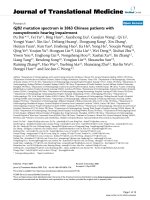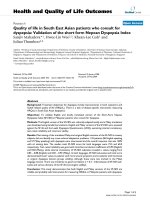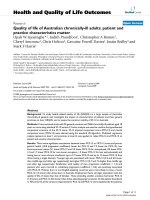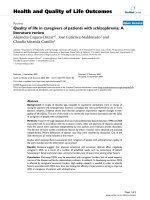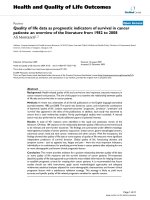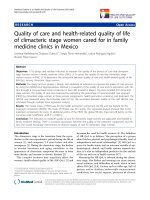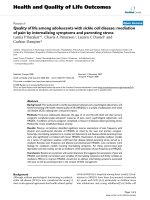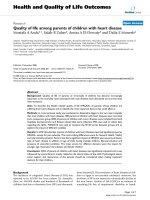báo cáo hóa học:" Quality of life in colon cancer patients with skin side effects: preliminary results from a monocentric cross sectional study" pot
Bạn đang xem bản rút gọn của tài liệu. Xem và tải ngay bản đầy đủ của tài liệu tại đây (489.38 KB, 7 trang )
Andreis et al. Health and Quality of Life Outcomes 2010, 8:40
/>Open Access
RESEARCH
BioMed Central
© 2010 Andreis et al; licensee BioMed Central Ltd. This is an Open Access article distributed under the terms of the Creative Commons
Attribution License ( which permits unrestricted use, distribution, and reproduction in
any medium, provided the original work is properly cited.
Research
Quality of life in colon cancer patients with skin
side effects: preliminary results from a monocentric
cross sectional study
Federica Andreis
1
, Anna Rizzi
1
, Paola Mosconi
2
, Claudia Braun
2
, Luigina Rota
1
, Fausto Meriggi
1
, Maria Mazzocchi
1
and
Alberto Zaniboni*
1
Abstract
Background: Epidermal growth factor receptor inhibitors are widely prescribed anticancer drugs. Patients treated
commonly develop dermatologic adverse drugs reactions, but rarely they are involved in systematic evaluation of their
quality of life. This monocentric cross sectional study is carried out to assess quality of life in colon cancer patients
experienced skin side effects due to anti epidermal growth factor receptor inhibitors therapy.
Methods: Consecutive patients with skin side effects to therapy treated at Fondazione Poliambulanza were enrolled in
this study. Quality of life was evaluated with the Italian validated version of Skindex-29 questionnaire, exploring three
dimensions: symptoms, emotional, and physical functioning. Skindex-29 was administered one time between the
eighth and the twelfth week of the treatment.
Results: Forty-five consecutive patients, mainly with metastatic colon cancer (29 female, 16 male), with an average age
of 59.31 years (ranging from 34-78) were included in the study and analyzed. Patients showed a great impact of skin
side effects on symptoms (mean 43), followed by emotional (mean 30), and functioning (mean 26) scales. In general
women, the 55-65 age class, and patients with partial remission reported the worst quality of life.
Conclusions: Epidermal growth factor receptor inhibitors' skin side effects have an important impact on quality of life
in advanced colon cancer patients; symptoms scale is the most effect respect to emotional and functioning scales.
Background
Epidermal growth factor receptor (EGFR) inhibitors, as
cetuximab or panitumumab, have become widely pre-
scribed anticancer drugs for the treatment of colorectal,
head and neck and lung cancer, alone or in combination
with traditional chemotherapy [1]. Patients treated with
EGFR inhibitors commonly develop a wide range of der-
matologic adverse drug reactions, including a papulopus-
tular rash, dry skin, itching and alterations in hair and
periungual tissues, which can result in a decreased qual-
ity of life (QoL) [2]. The rash can occur in 50-90% of
patients treated, arising primarily on the face, and
appearing similar, but non identical, to acne. The rash can
be painful and the paronychial cracking, the paper-cut
feeling in the fingers and toes can become very disturb-
ing, and could interfere with the daily activities of a rele-
vant proportion of patients [3]. Moreover many patients
experience significant skin side effects and find that these
are the first physical appearance of the disease; this situa-
tion could imply that many patients withdraw from social
activities because of the impact on their appearance and
their concerns about how others would react. As a conse-
quence, specific skin toxicities associated with EGFR
inhibitors can have a profound impact on patient's physi-
cal, emotional and social functions, the typical dimen-
sions assessed in QoL evaluation. Some data reported in
the literature regard cancer or colon cancer patients that
experienced skin side effects, but rarely patients are
requested to evaluate the impact of these problems on
their life and activities, or to participate in a QoL survey
[4,5].
* Correspondence:
1
UO di Oncologia Medica, Fondazione Poliambulanza, Via Bissolati 57, 25124
Brescia, Italy
Full list of author information is available at the end of the article
Andreis et al. Health and Quality of Life Outcomes 2010, 8:40
/>Page 2 of 7
The present study was carried out to evaluate the
impact on QoL in a population of patients with advanced
colon cancer who experience at least grade II skin side
effects according with National Cancer Institute-Com-
mon Terminology Criteria (NCI-CTC). We used the Ital-
ian version of a well-known dermatological instrument,
the Skindex-29 questionnaire [6-8], which is able to bet-
ter describe and score the real impact of skin toxicities on
daily QoL.
Methods
This cross sectional study was conducted at the Oncolog-
ical ward of the Fondazione Poliambulanza from March
to December 2008. Consecutive patients, not enrolled in
clinical trial, mainly with metastatic colon cancer, who
experienced, during the EGFR inhibitors treatment, at
least a grade II skin side effects scored as reported in
Table 1, were asked to participate in the study. The study
was approved from the Institutional Review Board of the
hospital, and all patients were provided with a written
informed consent before entering the study. Eligible
patients were Italian speaking older than 18 years of age.
All patients were informed on their diagnosis and prog-
nosis, information was conveyed thought medical consul-
tations, and written material.
Following a literature review [9], the Italian version of
Skindex-29 was chosen to evaluate the impact of skin
reactions considering its documented validity and reli-
ability [6-8]. This questionnaire has been previously vali-
dated in Italian language as described in detail elsewhere
[10]. Skindex-29 is a disease-specific self-administered
questionnaire that measures the complex effects of skin
disease on patients' QoL through three multi-item scales:
physical symptoms (7 items), emotional state (10 items),
and social function (12 items). Answers to each item are
given on 5-point scale, from 'never' to 'all time'. For each
scale the score is calculated as the mean of response to
the items included in the scale and the scale scores are
standardized to 100 [8]. According with the literature,
when missing data were less than 20% of the items
included in a scale, missing value was substituted by the
mean of the total score of the scale [11]. Higher scores
indicate an increase impact of skin side effects on QoL,
i.e. a worse patient's QoL.
After informed consent had been obtained, the Skin-
dex-29 questionnaire was presented by a trained inter-
viewer (AF); patients completed the self-administered
questionnaire during a routine visit but before medical
examination in order to reduce possible influence on
patient responses.
The questionnaire was administered between the
eighth and the twelfth week of the treatment, only one
time for each patients, according to a cross-sectional
design.
Statistical analyses were performed by SAS
®
System.
Clinical and demographic variables were described using
descriptive statistics such as mean, standard deviation
and proportion. Frequency distributions of survey ques-
tions were obtained by all the sample. In addiction we
constructed the three scales' index - symptoms, function-
ing and emotional - using the mean of the total score of
the scale and standardizing scores to 100. The mean of
the scales is analysed in function of sex, age (three levels),
clinical outcomes, and age classified by sex.
Results
Among ninety-four screened patients, forty-five consecu-
tive colon cancer patients experienced at least a grade II
skin toxicity and were therefore enrolled in the study. The
Skindex-29 has been very well accepted by this sample of
cancer patients since it hasn't been any refuse to partici-
pate, and we registered only three missing answers at
item level. The estimated Cronbach coefficient alpha
value for these colon cancer patients were .85, .84, .89 for
symptoms, emotion, and functioning respectively.
The demographic characteristics of patients are listed
in Table 2. There were 29 female (64%) and 16 male (36%)
with an average age of 59.31 years (ranging from 34 to 78
years). High-school graduation and university education
was achieved in the 36% of the patients enrolled, most of
patients are married. Thirty of forty-five patients received
the treatment as second or further lines for metastatic
disease; one third of patients experienced a grade 3 skin
toxicity (14 subjects), two thirds a grade 2 skin toxicity
(31 subjects).
The three health related QoL scores measured with the
Skindex-29 questionnaire in our population showed a
great impact of skin side effects on symptoms (mean 43),
followed by emotional (mean 30), and functioning (mean
26) scales, as reported in Table 3. All the three scores are
higher (worst QoL) in the subgroup sample of females;
the worst scores are in the 55-65 age class. When data
were analysed according with sex and age, the class of
women aged 55-65 years have the higher value of symp-
toms, emotional and functioning scales. Patients with
partial response have the worst QoL. As expected
patients with 3 grade toxicity reported a worst scores
(worst QoL) for all the scales considered respect to
patients with 2 grade toxicity, however the most relevant
difference is related to the symptoms scale.
Since the subgroups analysis showed very small sample
of patients, we couldn't perform analysis to test statistical
significance differences.
Discussion
Psychological effects of anti-EGFR-induced cutaneous
toxicities are increasingly recognized as an important
issue to cope with for both patients and physicians [2,3].
Andreis et al. Health and Quality of Life Outcomes 2010, 8:40
/>Page 3 of 7
Nevertheless, up till now there is a substantial lack of pro-
spective clinical trials, reporting data on QoL during anti-
EGFR therapy in colon cancer patients. Recently, Au et al
reported the QoL of patients with advanced colorectal
cancer treated with cetuximab, utilizing the EORTC
QLC-C30 questionnaire. In this study, cetuximab offered
an important benefit in terms of QoL compared with best
supportive care alone [12]. Interestingly, Peeters et al,
suggested that panitumumab monotherapy is associated
with better QoL scores, using a modified Dermatology
Life Quality Index questionnaire, and supported the use
of dermatological-oriented questionnaire (like Skindex-
29) to better capture key-symptoms potentially harmful
for QoL in this setting [13]. In Table 4, a comparison with
available literature data is presented where not only onco-
logical patients are considered [8,11,14,15]. Respect to
other conditions, the impact of skin side effects on colon
cancer patients is relevant for all the three scales consid-
ered. In particular the impact on symptoms is as impor-
tant as that recorded in patients with psoriasis, while
when compared to dermatological diseases as psoriasis,
eczema, or acne vulgaris the impact on the emotional
scale is lower.
It should be underlined that there is a direct association
between the development of skin toxicities (mainly rash)
and the probability of getting a good response from the
Table 1: National Cancer Institute common terminology criteria for grading selected dermatologic adverse events*
Grade Dry Skin Nail changes Pruritus/Itching Rash/
Desquamation
Rash: Acne/
Acneiform
1 Asymptomatic Discoloration,
ridging, pitting
Mild or localized Macular or
papular eruption,
or erythema
without
associated
symptoms
Intervention not
indicated
2 Symptomatic, not
interfering with
activities of daily
living (AOL)
Partial or
complete loss of
nail(s); pain in
nails
Intense or
widespread
Macular or
papular eruption,
or erythema with
pruritus or other
associated
symptoms;
localized
desquamation or
other lesions
covering < 50%
body surface area
(BSA)
Intervention
indicated
3 Interfering with
ADL
Interfering with
ADL
Intense or
widespread and
interfering with
ADL
Severe,
generalized
erythroderma, or
macular, papular
or vesicular
eruption;
desquamation
covering
> 50% BSA
Associated with
pain,
disfigurement,
ulceration, or
desquamation
4 - - - Generalized,
exfoliative,
ulcerative, or
bullous dermatitis
-
5 DeathDeath
* From Common terminology criteria for adverse events v3.0, by the National Cancer Institute, 2003. Retrieved September 2, 2005, from http:/
/ctep.cancer.gov/reporting/ctc.html. Reprinted with permission
Andreis et al. Health and Quality of Life Outcomes 2010, 8:40
/>Page 4 of 7
treatment [16,17]. Patients are generally informed about
this kind of correlation since the start of the treatment
and this awareness should be taken into account in the
coping process of patients with their toxicities. Our study
documents in a sample of advanced colon cancer patients
the impact of skin side effects on symptoms, emotional
and functioning scales, with the impact on symptoms
worse than other scores scales. Interestingly scores vary
according with sex, age, the achievement of partial remis-
sion, and grade of toxicity suggesting to reserve special
attention to psychological support, doctor-patient rela-
tionship and in providing these groups of patients with
accurate and truthful information. In respect to compara-
tive data of subjects with skin clinical problems, our sam-
ple of colon cancer patients showed in general a worse
impact on symptoms and functional QoL scales. Surpris-
ingly, the impact on emotional scale is less important
when compared with patients with other skin problems.
Table 2: Characteristics of sample considered, n° = 45
N° %
Sex Female 29 64.4
Male 16 35.6
Age (year) Mean and standard deviation
(min-max)
59.31 ± 9.94 (34-78)
Education Elementary 13 28.8
Secondary school 16 35.6
High school 16 35.6
Status Married/live together 39 86.7
Single 6 13.3
Treatment Adjuvant 5 11.1
First line 9 20.0
Second line 18 40.0
Third line 12 26.7
Other 1 2.2
Outcome Partial remission 16 35.6
Stable disease 14 31.1
Progressive disease 10 22.2
Not evaluable 5 11.1
Andreis et al. Health and Quality of Life Outcomes 2010, 8:40
/>Page 5 of 7
The severity of clinical condition (mainly metastatic
colon cancer patients), the impact of the disease and
relapse may partially explain this different focus on the
items considered in the emotional scale. It is reasonable
to think that some items like "I worry that my skin condi-
tion may be serious (item 3), " makes me feel depressed"
(item 6), or "I am angry about my skin condition" (item
15) may affect differently in a population with a limited
perspective of survival as patients in this study.
As expected, the worst scores were noted in responding
and in 3 grade toxicity patients, considering the link
between skin toxicity and drug activity, as mentioned
before and reported by literature [16,17]. It could be that
the lower than expected impact of treatment on emo-
tional, symptom, functioning scales is due to the aware-
ness of correctly informed patients of the relationship
between intensity of toxicity and positive response to the
treatment. This awareness may, to some extent, mitigate
the significance of certain items like shame, social isola-
tion, sexuality.
Currently there is no evidence-based treatment guide-
line to prevent or treat the EGFR inhibitor-associated
skin toxicities, except for a recently reported strategy of
preventive treatment considered in a small randomized
study [18-20]. At the moment consensus emphasizes the
importance of developing an interdisciplinary approach
Table 3: Skindex-29 scores by patients characteristics
SKINDEX-29 SCALES
Symptoms
Mean SD (min-max)
Emotional
Mean SD (min-max)
Functioning
Mean SD (min-max)
Total sample (n° = 45) 43.33 ± 20.22 (07-96) 30.33 ± 14.16 (05-67) 26.85 ± 17.57 (0-62)
Sex
Male (n° = 29) 41.87 ± 18.55 (07-82) 29.31 ± 12.98 (05-57) 24.71 ± 16.74 (00-56)
Female (n° = 16) 45.98 ± 23.26 (07-96) 32.18 ± 16.35 (05-67) 30.73 ± 18.93 (00-62)
Age - 3 levels
34-54 years (n° = 13) 42.58 ± 20.64 (07-71) 29.80 ± 14.45 (05-50) 24.67 ± 21.97 (00-60)
55-65 years (n° = 19) 46.05 ± 23.20 (07-96) 32.23 ± 16.24 (05-67) 29.49 ± 15.82 (04-62)
> 65 years (n° = 13) 40.10 ± 15.57 (07-71) 28.07 ± 10.90 (05-50) 25.16 ± 15.96 (00-52)
Age 3 and Male
34-54 years (n° = 6) 48.80 ± 13.67 (25-64) 34.16 ± 09.57 (17-45) 19.79 ± 18.71 (04-54)
55-65 years (n° = 13) 42.30 ± 23.04 (07-82) 29.61 ± 16.13 (05-57) 26.92 ± 16.12 (04-56)
> 65 years (n° = 10) 37.14 ± 14.20 (07-53) 26.00 ± 09.94 (05-37) 24.79 ± 17.52 (00-52)
Age 3 and Female
34-54 years (n° = 7) 37.24 ± 24.98 (07-71) 26.07 ± 17.49 (05-50) 28.86 ± 25.09 (00-60)
55-65 years (n° = 6) 54.16 ± 23.41 (28-96) 37.91 ± 16.38 (20-67) 35.06 ± 14.93 (20-62)
> 65 years (n° = 3) 50.00 ± 18.89 (35-71) 35.00 ± 13.22 (25-50) 26.38 ± 12.02 (12-33)
Clinical outcome
Partial remission (n° = 16) 45.98 ± 18.98 (07-71) 32.18 ± 13.28 (05-50) 28.51 ± 19.55 (00-56)
No remission (n° = 29) 41.87 ± 21.06 (07-96) 29.31 ± 14.74 (05-67) 25.93 ± 16.68 (00-62)
Grade skin toxicity
2 (n° = 31) 39.28 ± 19.64 (07-82) 27.50 ± 13.75 (05-57) 23.11 ± 16.28 (00-60)
3(n° = 14) 52.29 ± 19.18 (18-96) 36.60 ± 13.43 (12-67) 35.12 ± 18.08 (06-62)
Andreis et al. Health and Quality of Life Outcomes 2010, 8:40
/>Page 6 of 7
involving specialists in oncology and dermatology. Nev-
ertheless, selected patients might benefit also from early
psychological support.
We are aware that our study has some limitations: the
sample size of this study is not very large, so the data
analysis is partial. However our patients population is
prospectively studied on a consecutive basis and might be
a quite representative sample of real-world clinical prac-
tice outside clinical trials. Another limitation is that this
study is cross-sectional: QoL has been evaluated at only
one time point instead of prospectively evaluating toxici-
ties' impact on aspects of life over time. Finally, consider-
ing the clinical conditions of patients included in this
study (mainly metastatic and cancer) it was not consid-
ered feasible in our setting to administer both a specific
and a generic questionnaire. For these reasons we
decided to use only one QoL questionnaire - the derma-
tological specific instrument Skindex-29 - which is able to
better describe and score the real impact of skin toxicities
on daily QoL, compared to generic tools as EORTC QLQ
C-30 or SF-36.
Conclusion
This study documents the impact of skin side effects on
quality of life of advanced colon cancer patients treated
with EGFR inhibitors. Among the evaluated scales con-
sidered by Skindex29 questionnaire, the symptoms scale
is the most effect respect to emotional and functioning
ones.
Future studies should also explore the combined use of
usually employed generic questionnaires and dermato-
logic-oriented tools, like Skindex-29, in an attempt to
better define the ultimate impact of EGFR therapeutic
approaches involving a constantly increasing number of
cancer patients.
Table 4: Comparison with literature data
SKINDEX-29 SCALES
Symptoms
Mean
Emotional
Mean
Functioning
Mean
Metastatic colon cancer
patients (45)
43 30 26
Psoriasis (45) [8]* 41 38 22
Eczema (103) 48 41 25
Benign growth (75) 21 21 8
New melanoma cancer (137) 27 20 9
Acne vulgaris (57) [14]** 29 39 15
Psoriasis (44) 42 38 24
Benign lesion (75) 23 21 8
Normative sample (107) 13 9 3
Cutaneus T-cell lymphomas
(22) [11]
19 23 24
First diagnosis of cutaneus B-
cell lymphomas (24)
15 20 5
First diagnosis of micosis
fungoide (59)
25 28 15
First diagnosis of Sezary
syndrome (12)
[15]***
70 52 45
() in the brackets the number of patients considered
* data from figure six of the original article
** data from figure two of the original article
*** data from figure three of the original article
Andreis et al. Health and Quality of Life Outcomes 2010, 8:40
/>Page 7 of 7
Competing interests
The authors declare that they have no competing interests.
Authors' contributions
All the authors actively participated to plan the study described in the article.
In particular:
AF, RA, RL, MF, DBB, AC and MM presented the study to patients, collected and
assembled data. BC and MP perform the data analysis and discussed results
with other authors. ZA and MP drafted the article and all the authors reviewed
it and gave final approval of the version to be published.
Author Details
1
UO di Oncologia Medica, Fondazione Poliambulanza, Via Bissolati 57, 25124
Brescia, Italy and
2
Istituto di Ricerche Farmacologiche Mario Negri, Via La Masa
19, 20156 Milano, Italy
References
1. Perez-Soler R, Van Cutsem E: Clinical Research of EGFR inhibitors and
related dermatologic toxicities. Oncology 2007, 21(11 Suppl 5):10-16.
2. Wagner LI, Lacouture M: Dermatologic toxicities associated with EGFR
inhibitors: the clinical psychologist's perspective. Oncology 2007, 21(11
Suppl 5):34-6.
3. Romito F, Giuliani F, Cormio C, Tulipani C, Mattioli V, Colucci G:
Psychological effects of cetuximab-induced cutaneous rash in
advanced colorectal cancer patients. Supportive Care Cancer 2009 in
press.
4. Labianca R, La Verde N, Garassino MC: Development and clinical
indications of cetuximab. Int J Biol Markers 2007, 22(1 Suppl):S40-6.
5. Gencoglan G, Ceylan C: Two cases of acneiform eruption induced by
inhibitor of epidermal growth factor receptor. Skin Pharmacol Physiol
2007, 20:260-2.
6. Chren MM, Lasek RJ, Quinn LM, Mostow EN, Zyzanski SJ: Skindex, a
quality-of-life measure for patients with skin disease: reliability,
validity, and responsiveness. Journal of Investigative Dermatology 1996,
107:707-13.
7. Chren MM, Lasek RJ, Quinn LM, Covinsky KE: Convergent and
discriminant validity of a generic and a disease-specific instrument to
measure quality of life in patients with skin disease. Journal of
Investigative Dermatology 1997, 108:103-7.
8. Chren MM, Lasek RJ, Flocke SA, Zyzanski SJ: Improved discriminative and
evaluative capability of a refined version of Skindex, a quality-of-life
instrument for patients with skin diseases. Archives of Dermatology
1999, 133:1433-40.
9. Both H, Essink-Bot ML, Busschbach J, Nijsten T: Critical review of generic
and dermatologic-specific health-related quality of life instruments.
Journal of Investigative Dermatology 2007, 127:2726-39.
10. Abeni D, Picardi A, Pasquini P, Melchi CF, Chren MM: Further evidence of
the validity and reliability of the Skindex-29: an Italian study on 2,242
dermatological outpatients. Dermatology 2002, 204:43-9.
11. Sampogna F, Frontani M, Baliva G, Lombardo GA, Alvetreti G, Di Pietro C,
Tabolli S, Russo G, Abeni D: Quality of life and psychological distress in
patients with cutaneous lymphoma. British Journal of Dermatology 2008,
160:815-22.
12. Au HJ, Karapetis CS, O'Callaghan CJ, Tu D, Moore MJ, Zalcberg JR,
Kennecke H, Shapiro JD, Koski S, Pavlakis N, Charpentier D, Wyld D, Jefford
M, Knight GJ, Magoski NM, Brundage MD, Jonker DJ: Health-Related
Quality of Life in Patients With Advanced Colorectal Cancer Treated
With Cetuximab: Overall and KRAS-Specific Results of the NCIC CTG
and AGITG CO.17 Trial. Journal of Clinical Oncology 2009, 27:1822-8.
13. Peeters M, Siena S, Van Cutsem E, Sobrero A, Hendlisz A, Cascinu S,
Kalofonos H, Devercelli G, Wolf M, Amado RG: Association of
progression-free survival and patient-reported outcomes by skin
toxicity and KRAS status in patients receiving panitumumab
monotherapy. Cancer 2009, 115:1544-54.
14. Lasek RJ, Chren MM: Acne vulgaris and the quality of life of adult
dermatology Patients. Archives of Dermatology 1998, 134:454-8.
15. Demierre MF, Tien A, Miller D: Health-related quality-of-life assessment
in patients with cutaneous T-cell lymphoma. Archives of Dermatology
2005, 141:325-30.
16. Saif MW, Longo WL, Israel G: Correlation between rash and a positive
drug response associated with cetuximab in a patient with advanced
colorectal cancer. Clinical Colorectal Cancer 2008, 7:144-8.
17. Gotlib V, Khaled S, Lapko I, Mar N, Saif MW: Skin rash secondary to
cetuximab in a patient with advanced colorectal cancer and relation to
response. Anticancer Drugs 2006, 17:1227-9.
18. Lo Russo P: Toward evidence-based management of the dermatologic
effects of EGFR inhibitors. Oncology 2009, 23:186-9.
19. Mitchell EP, Lacouture M, Shearer H, Iannotti N, Piperdi B, Pillai M, Xu M,
Yassine M: Final STEPP results of prophylactic versus reactive skin
toxicity treatment for panitumumab-related Skin toxicity in patients
with metastatic colorectal cancer. Journal of Clinical Oncology 2009,
27(Suppl 18):CRA4027.
20. Lacouture M, Mitchell EP, Piperdi B, Pillai MV, Shearer H, Iannotti N, Xu M,
Yassine M: Skin toxicity evaluation protocol with panitumumab
(STEEP), a phase II, open-label, randomized trial evaluationg the
impact of a pre-emptive skin treatment regimen on skin toxicities and
quality of life in patients with metastatic colorectal cancer. Journal of
Clinical Oncology 2010, 28:1351-1357.
doi: 10.1186/1477-7525-8-40
Cite this article as: Andreis et al., Quality of life in colon cancer patients with
skin side effects: preliminary results from a monocentric cross sectional study
Health and Quality of Life Outcomes 2010, 8:40
Received: 17 July 2009 Accepted: 15 April 2010
Published: 15 April 2010
This article is available from: 2010 Andreis et al; licensee BioMed Central Ltd. This is an Open Access article distributed under the terms of the Creative Commons Attribution License ( ), which permits unrestricted use, distribution, and reproduction in any medium, provided the original work is properly cited.Health and Quality of Life Outcomes 2010, 8:40
